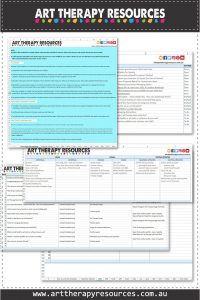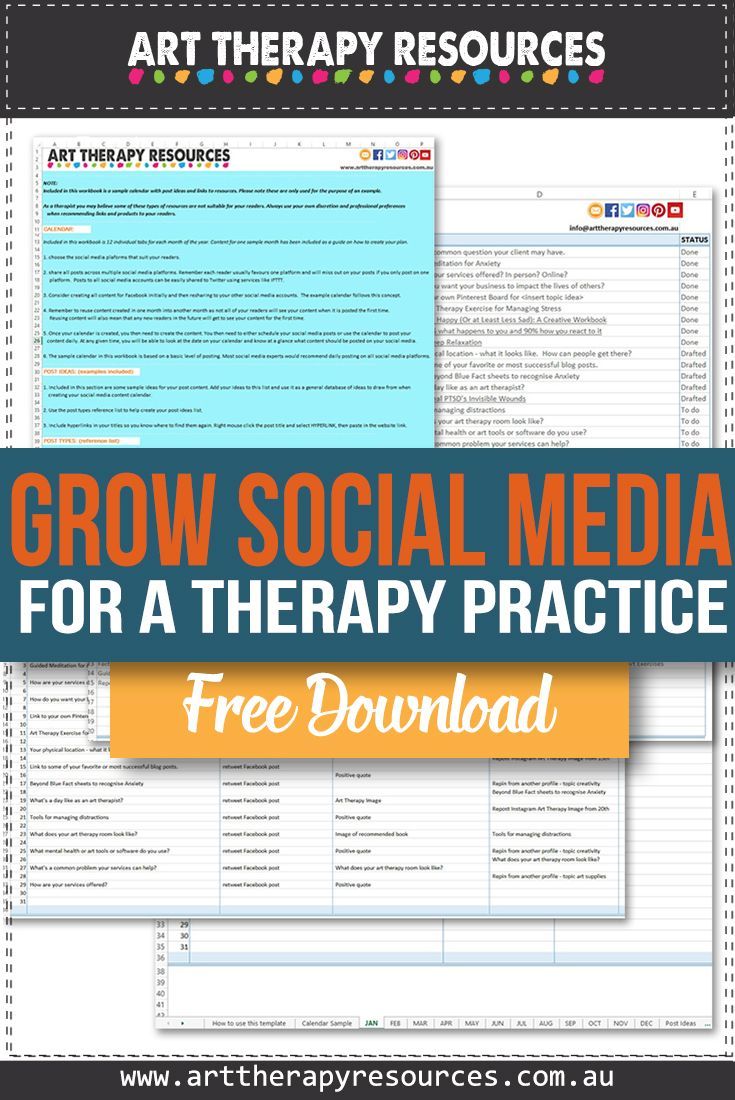THIS POST INCLUDES:
1. Benefits of Social media for a Therapy Practice
2. Choose your Social Media Platforms
3. Create a Social Media Workflow
4. Free Download Annual Social Media Plan Template
BENEFITS OF SOCIAL MEDIA FOR A THERAPY PRACTICE
Generally, a social media presence will add to the legitimacy of your business as it represents a public face for your private practice.
You may think that having a website should be enough for your therapy practice to market your services, however, this is true if your potential clients already know you exist. In this case, you are expecting clients to come to find you, and more importantly, find you amongst all the other therapy practices out there. Social media means you go to where your potential clients already are and introduce your services to them. If they respond to your message, they will visit your website for more information.
This part of marketing your therapy practice can be an uncomfortable part of running a practice. However, like all businesses, your potential clients need you to introduce yourself to find you. It is true that you can also be found organically through search and other word-of-mouth services, however, this is a passive way of hoping your potential clients find you. Having a social media presence is a proactive measure you can take to ensure your therapy practice is visible to many people who may not otherwise seek out your business.
Having a social media presence allows you to introduce yourself to potential clients, however, it also gives you a way to communicate with your potential clients. Through your posts, readers can learn about your services, your skills, and what is important to you as a therapist. Through social media posting, you have the opportunity to post this information in-depth and regularly so that your client base can develop a deeper understanding of who you are as a therapist.
Having social media accounts can add another layer of administrative work to your schedule, however, with some strategic steps, you can reduce the amount of effort required to use these platforms. We cover this later when we discuss creating a social media workflow.
CHOOSE YOUR SOCIAL MEDIA PLATFORMS
It is difficult to dedicate a lot of time to manage multiple social media accounts, so the best approach is to focus on 1 or 2 and then repost content from those platforms to additional platforms for your readers. This provides you with the benefit of additional exposure across multiple platforms but also ensures you are remaining focused on your most active social media channels.
Below is a summary of the posting style of each major platform:
- Facebook – good for longer form content such as videos, visuals, and articles. A lot of content is shared on Facebook.
- Twitter – primarily for text and networking. Limitations on content size can limit topics.
- Instagram – mostly focuses on visual content
- TikTok – video based content and is primarily a sharing platform rather than brand building platform
- YouTube – good for educational and entertainment based content
- Pinterest – a good place to organise and store internet based content
Each platform is used by many users but more than likely has a core demographic based on its age. Most older users can be found on Facebook and most younger users can be found on TikTok and Instagram.
DEVELOP A POSTING STRATEGY
When you have chosen your platforms, it is time to create your social media strategy. You will need a strategy for each platform as they all represent different ways to engage with your readers.
The most common strategies to use across each platform include:
- Develop branding – design branding that makes your account stand out from the rest. Use well designed logos, colours, and graphics that make your practice stand out and become familiar to your audience.
- Post consistently – the algorithms of each platform favour consistent posting as a way of ensuring you stay engaged with your readers
- Hashtags – most social media platforms use hashtags as a way of helping readers find niche topics that interest them
- Engagement – answer your reader’s questions online and engage with similar accounts that help you build a community around your niche
One way to decide what platform/s you may want to use is to see how many art therapists or therapists are already on each platform. The presence of many other therapists on a specific platform may give you some insight into the best demographics for your therapy practice.
CREATE A SOCIAL MEDIA WORKFLOW
Systems are usually the best way to eliminate or reduce onerous administrative tasks. This can also apply to how you manage your social media content.
A workflow helps you establish the steps in your social media marketing efforts. An effective workflow is usually formally constructed and most importantly it is repeatable so that all of the steps in the workflow are started and completed as efficiently and quickly as possible.
For social media a typical workflow will include the following processes:
- Planning
- Content writing
- Images
- Marketing – hashtags, keywords
- Review of 5 Free Social Media Schedulers
As you can see there are many parts to managing social media. If you are a sole business owner with a limited budget, you may need to complete all of the parts of your social media content marketing. To do this it’s essential to have a simplified workflow put in place to help you successfully plan, create, and distribute your social media content.
As your private practice grows, your ability to invest time in social media marketing will reduce while your need to use it will increase. Creating a workflow in the beginning stages of your social media use will help establish good time management practices for your business in the future to help you focus on growing your private practice.
To create your social media workflow, you can use the following steps to help define your message and put steps in place to ensure you post regular and meaningful content to your social media platforms.
- Identify social media accounts – experiment with a few different social media platforms to see where you gain most of your traffic and engagement from
- Define the message for each social media account – As you decide on the social media platforms that you want to use with your private practice, it is good to define the type of content that you want to share on each platform. For example, you may want to share worksheets on Pinterest, show art making processes on Instagram, or publish long form written content about anxiety on Facebook.
- Make content creation tasks easier – create content in batches and publish that content over time. Repeat, reuse, and recycle effective content to reach your audience
- Define your posting schedule – Using an automated scheduler will make this process easier as you can easily choose times, days, and the number of times to repeat content.
- Creating content – To create your content more efficiently, check out our previous blog post: How to Create an Annual Social Media Plan in 60 mins
You can find more in-depth writing on creating a social media workflow in our previous blog post here: Create a Social Media Workflow for a Therapy Practice
FURTHER READING:
For more information on using social media for your private practice, check out our previous blog posts listed below:
FREE DOWNLOAD: Annual Social Media Plan Template
Download the Annual Social Media Plan Template.

BUILD YOUR ART THERAPY REFERENCE MATERIALS:
Pin this image to your Pinterest board.

SHARE KNOWLEDGE & PASS IT ON:
If you’ve enjoyed this post, please share it on Facebook, Twitter, Pinterest. Thank you!
